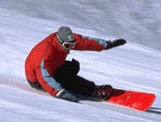

|
|
|||||||
|
|
|
Plyometrics Training Plyometrics increase strength and speed in a way that weight training by itself can't. By training the muscle to contract quickly while overloaded you gain explosiveness and control under tension The rider needs this specific strength for jumps, landings, and uneven terrain. One word of caution. Plyos are a great exercise, but should not be overused. Once or twice a week with step or box bounding (4 inch height to start) is plenty. Advanced only! For high box jumping (12 inches or more) I recommend that you be able to regular squat your own body weight before you begin (meaning, if you weigh 185 pounds, you should be able to place 185 on your upper back and perform a squat. Jump-rope is a pretty good plyometric activity and also benefits the cardiovascular systems. Try it out! I'll try to post a few plyo exercise pics as they become available. Plyometrics sheet (PDF: 15kb) - Adobe Acrobat Reader required The Details
|
|
Copyright 2001, Ron McConnell. All rights reserved. |
